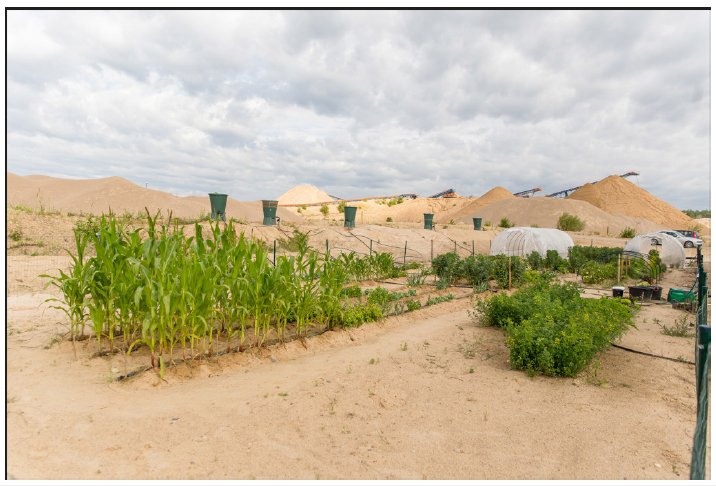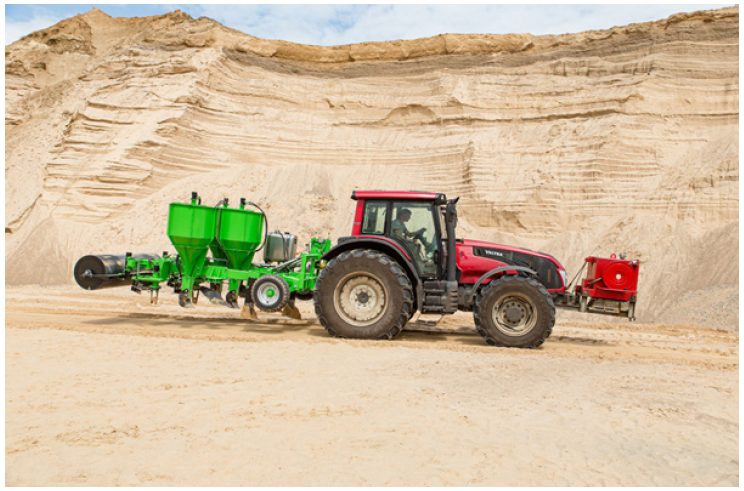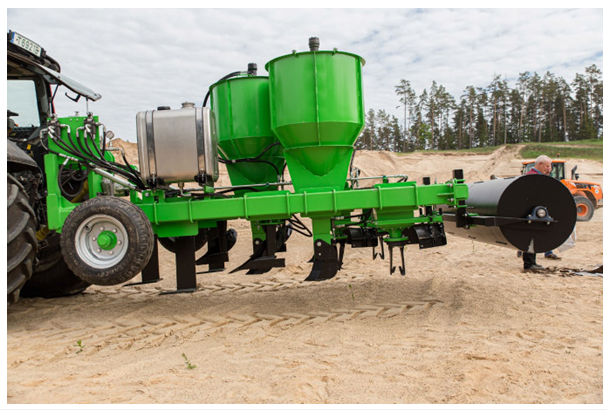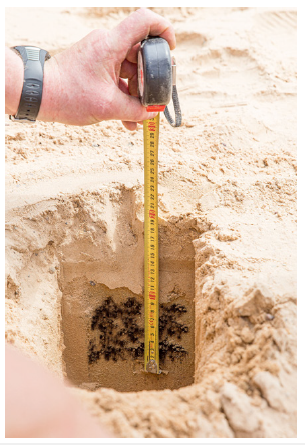- Submissions

Full Text
Journal of Biotechnology & Bioresearch
Scarabaeus Technology can Make the Desert Bloom Five Times Cheaper
Fullen MA1*, Mokrik R2, Juozapavičius G2, Steponavičius P2 and Steponavičius A2
1The University of Wolverhampton, School of Architecture and the Built Environment, Grimstone Street, Wolverhampton, UK
2GJ Magma Ltd, Vilnius, Lithuania
*Corresponding author: Fullen MA, The University of Wolverhampton, School of Architecture and the Built Environment, Grimstone Street, Wolverhampton, UK
Submission: July 23, 2022;Published: September 01, 2022

Volume4 Issue2 September, 2022
Abstract
Sapropel is a freshwater lake organic-mineral sediment complex, with estimated global reserves exceeding 100 billion tonnes. Sapropel can provide nutrients to soil-crop systems, including nitrogen, phosphorus, potassium, calcium, magnesium, manganese, zinc, boron, copper, iron, and biologically active organic matter. Laboratory and field investigations have demonstrated that sapropel treatments can significantly restore and improve the agrophysical, agrochemical, microbiological and biochemical properties of degraded and infertile soils for a period of up to 4-5 years and increase agricultural crop yields over that period. Thus, sapropel can be used in multifunctional agro-environmental technologies. However, despite the positive properties of sapropel, it is not used to its full potential. This is largely due to the high application rate of sapropel (typically 60t ha-1) needed to guarantee effectiveness and thus the associated high costs of processing and transporting the bulky material. Field experiments are in progress in Serapiniškės gravel/sand quarry in south-east Lithuania.
By applying precision agriculture Scarabaeus technology, non-productive soil is modified by targeting the local insertion of organic soil improver to specific underground inserts of sapropel ameliorant. The tractor-led agricultural machine (Scarabaeus) allows direct insertion of sapropel into the rooting zone (Rhizosphere). Thus, conditioners are only applied to the plant growth lines and directly into the root growth zone in 15cm diameter inserts of sapropel. The upper edge of the sapropel insert is usually set at 10-15cm depth beneath the plowed topsoil and the spacing between inserts is typically 55-75cm. This enables the soil improver to be added to specific localized underground inserts rather than onto the entire modified area, thus reducing the application rate five-fold. Fully replicated experiments were undertaken in 2019 and 2020 and further investigations are on-going. In the furrows with local application of the ameliorant at 11t ha-1 with the Scarabaeus machine, similar yields were obtained as in the furrows, where 60t ha-1 was applied in the traditional manner. Analysed soil physico-chemical properties included Soil Organic Matter (SOM), nutrient concentrations, the chlorophyll content of leaves, soil moisture, soil temperature and soil electrical conductivity. Direct soil treatment effects on soil biota were evident from the application of sapropel ameliorant. In soil samples taken from 0-10 and 10- 20cm in 2019, sapropel significantly increased soil respiration, the biomass of microorganisms, enzymatic activity, provided SOM, improved soil moisture retention, and decreased soil pH to levels suitable for crop production. Significant effects (P<0.001) were consistent in five sampled crops (fava beans, common beans, potatoes, and maize) and were particularly evident in the increased crop yield of leeks. Thus, the artificial soil produced using Scarabaeus technology was a suitable substrate for crop production. The evidence supports the premise that the technology has potential to improve agro-environmental conditions on sandy infertile soils in multiple climatic conditions, especially in arid areas, and thus merits further investigations.
Keywords: Sapropel; Lakes; Soil conditioners; Soil fertility; Precision agriculture; Rhizosphere; Arenosols; Aridisols; Pedogenesis
Introduction
Sapropel is a freshwater lake organic-mineral sediment complex. The extraction and application of sapropel can be used in multifunctional agro-environmental technologies. Field and laboratory experiments indicate sapropel can create artificial fertile soil for a limited period of four-to-five years on land which is unsuitable for crop production. Application of sapropel effects soil chemistry, biology, and crop production. Thus, it is essential that the geochemical quality of sapropel is analyzed to verify it complies with environmental legislation [1]. It is crucial that the sapropel is not polluted by heavy metals or oil-based hydrocarbons. Extraction of sapropel cleans source-lakes, thus maintaining their ecological integrity and preventing the lakes from deteriorating into unproductive marshland.
On extraction, sapropel is usually dewatered, which is achieved by the combined effects of air-drying and freeze-drying in winter. The sapropel is then processed (typically by modifying its colloidal properties) to create the requisite properties necessary for use as a sustainable soil improver. The processed sapropel can then be applied to contaminated and degraded soils as a fertilizer and/ or soil conditioner. Sapropel can also be applied to soils affected by desertification processes to create the properties necessary for crop production. Sapropel is a sustainable, natural, and slowly renewable resource that is present in large quantities in northern Europe. Lithuania has the largest sapropel reserves within the European Union, estimated to be 1.5-2.0 billion tonnes. In addition, estimated reserves in Latvia are 1.5B tonnes and 1.2B tonnes in Estonia. Estimated reserves in Belarus are over 4B tonnes and estimated global reserves exceed 100B tonnes. There are also extensive sapropel resources in Ukraine, Poland, Sweden, and Canada, but reliable accessible information about the amount of these resources is not currently available.
Initial field experiments in arid environments were conducted by Professor Nicolaj Bambalov and Dr Guennadi Sokolov from the National Academy of Sciences of Belarus (Minsk). They have investigated the fundamental physico-chemical and biological properties of sapropels [2-7]. They have also made progress in investigating the potential of these sapropels to improve the agricultural potential of arid soils, specifically in Egypt (field investigations 1994-96), the United Arab Emirates (UAE) (1989- 90) and the Kingdom of Bahrain (2002-04). On desert soils, yields were obtained that were equivalent to those on the fertile soils of the Nile Delta. These scientific experiments established that the optimum application rate of sapropel to the soil was 60t ha-1. The experiments also found that sapropel ameliorant can decrease irrigation water requirements by ≤50% [6].
Laboratory and field investigations have demonstrated that sapropel treatments can significantly restore and improve the agrophysical, agrochemical, microbiological and biochemical properties of degraded and infertile soils and increase agricultural crop yields for a period of up to 4-5 years [8,9]. Sapropel provides a rich source of organic matter and contains most macro-and micronutrients necessary for full and successful plant and crop growth. These include the Macro-nutrients nitrogen (N), Phosphorus (P), Potassium (K), Calcium (Ca) and Magnesium (Mg) and the Micronutrients manganese (Mn), Zinc (Zn), Boron (B), Copper (Cu) and Iron (Fe). Furthermore, sapropels accommodate relatively low quantities of cellulose decomposing bacteria, supporting slow mineralization and enabling prolonged fertilizer-life, compared with other organic fertilizers [10]. For instances, increasing Soil Organic Matter (SOM) content increases water retention capacity, the capacity of extractable bases to supply macro- and micro Laboratory and field investigations have demonstrated that sapropel treatments can significantly restore and improve the agrophysical, agrochemical, microbiological and biochemical properties of degraded and infertile soils and increase agricultural crop yields for a period of up to 4-5 years [8,9]. Sapropel provides a rich source of organic matter and contains most macro-and micronutrients necessary for full and successful plant and crop growth. These include the Macro-nutrients nitrogen (N), Phosphorus (P), Potassium (K), Calcium (Ca) and Magnesium (Mg) and the Micronutrients manganese (Mn), Zinc (Zn), Boron (B), Copper (Cu) and Iron (Fe). Furthermore, sapropels accommodate relatively low quantities of cellulose decomposing bacteria, supporting slow mineralization and enabling prolonged fertilizer-life, compared with other organic fertilizers [10]. For instances, increasing Soil Organic Matter (SOM) content increases water retention capacity, the capacity of extractable bases to supply macro- and micronutrients, soil aggregate stability, soil aeration and concomitantly decreases physical degradation (compaction, surface sealing and crusting) and soil erodibility. Sapropel constituents include bioactive substances, including vitamins, enzymes, and antibiotics [11]. There have been few evaluations of possible pharmaceutical and/or therapeutic applications of sapropel [12-14].
Field Experiments in Lithuania
Despite all the positive properties of sapropel, it is not used to its full potential. This is largely due to the high application rate of sapropel needed to guarantee effectiveness (typically 60 t ha-1) and the associated high costs of processing and transporting the bulky material. GJ Magma Ltd. of Vilnius is implementing Project No. J50- LVPA-K-04-0095 (funded by European Union Structural Funds), which allows the application rate of sapropel to be decreased fivefold.
By applying precision agriculture Scarabaeus technology, non-productive soil is modified by targeting the local insertion of organic soil improver to specific underground inserts of sapropel ameliorant. Thus, conditioners are only applied to the plant growth lines and directly into the root growth zone in 15cm diameter sapropel inserts. The upper edge of the sapropel ameliorant insert is usually set at 10-15cm depth beneath the plowed topsoil. The spacing between these inserts is typically 55-75cm. This enables the soil improver to be added to specific localized underground inserts rather than onto the entire modified area, thus reducing the application rate five-fold.
A 10-15cm layer of soil above the sapropel insert protects it from the destructive effects of the sun and wind, as well as from scattering due to subsequent light tillage during harvesting. This enables the soil improver to function effectively for four-to-five years. The coordinates of the underground inserts are recorded by the tractor’s GPS system and can thus be located during sowing. The Scarabaeus technology is suitable for a five-fold decrease in the usual application rates of sapropel ameliorant, granulated manure, vermicompost, compost and other soil conditioners.
Field experiments are being conducted in Serapiniškės gravel/sand quarry in the Trakai district of south-east Lithuania (54.612116oN, 25.012753oE) (Figure 1). The research team includes scientists from Lithuania, Latvia, and Belarus. The Serapiniškės test field was established on May 15, 2019. The Serapiniškės quarry soils are 91% sand, 8% gravel and 1% fines (silt and clay). The SOM content was low (0.17%) and soil pH was high (9.94). Thus, the soils replicate characteristics generally associated with arid soils (Aridisols in the US Soil Taxonomy; Arenosols, Calcisols and Gypsisols in the World Reference Bureau Classification, WRB) [15]. Thus, the simulation is realistic in a pedoenvironmental context. However, understandably, it is not possible to replicate the climatic conditions of hot arid environments in the field. These conditions have been partly addressed using two greenhouses. The greenhouses also protect crops from precipitation, which is typically ~760mm per year in this region.
Figure 1:Field experiments in serapiniškės gravel/sand quarry in the Trakai district of south-east Lithuania.

Figure 2: Tractor and Scarabaeus machine at the test site.

Fully replicated experiments were undertaken in 2019 and 2020 and soil monitoring for 2021-22 is on-going. Soil and crop analyses were performed by Certified Laboratories and data are subjected to appropriate statistical analyses. A novel aspect of the research is the design of a tractor-led agricultural machine (Scarabaeus) for direct and effective delivery of sapropel into the rooting zone (Rhizosphere) (Figures 2-4). The research team have carefully monitored the field performance of the Scarabaeus technology and it has proved successful in fulfilling its specified role. The team is also modifying the prototype to optimize the amount and depth of soil conditioner application. Having a system which can be modified to optimize performance in multiple arid environments (i.e., for different soil and crop conditions) would enhance the applicability of the system.
Figure 3: Overview of the Scarabaeus machine.

Figure 4:Micro-profile of sapropel insert.

The usual application rate of Sapropel is 60t ha-1. However, this application rate is not financially viable. The experiments made a targeted local application equivalent to 11t ha-1 in the rhizosphere (i.e., 18% of the normal field application rate). Treatments included 11t ha-1 of sapropel by traditional surface application, 60t ha-1 of sapropel using the traditional surface application, and local application by the Scarabaeus machine at 11t ha-1. In the furrows with local application of the ameliorant at 11t ha-1 with the Scarabaeus machine, yields were obtained corresponding to the yields in the furrows, where 60t ha-1 was applied in the traditional manner.
In 2019, the studied crops were: radish, lettuce, maize, fava beans, common beans, potatoes, cabbages, carrots, red beet, celery, and leeks. In 2020, the studied crops were: maize, potatoes, onions, common beans, cabbage, radish, leeks, lettuce, fava beans and red beet. Analysed soil physico-chemical properties included SOM and concentrations of total N, total soil P, total soil K, soil Mg and the chlorophyll content of leaves. Complementary measurements were made of soil moisture, soil temperature and soil electrical conductivity. These simultaneous measurements were taken using a Eijkelkamp W.E.T. Sensor Kit HH2 Moisture Meter. All analytical techniques adopted internationally recognized protocols and thus the data are of repeatable quality.
In 2019, the non-significant responses of both radish and carrots could be attributed to the shallow nature of the crop roots not penetrating to the sapropel layer. In 2020, the non-significant responses of both radish and potatoes may also be attributed to insufficient root penetration and/or the insertion of the ameliorant at too great a depth. Evidence supports the assertion that the Scarabaeus technology should be amenable to modification of field operation protocols to optimize nutrient uptake from the rhizosphere.
Direct soil treatment effects on soil biota were evident from the application of sapropel ameliorant. In soil samples taken from 0-10 and 10-20cm in 2019, sapropel significantly increased soil respiration, the biomass of microorganisms and enzymatic activity. There was also evidence of developing symbiotic activity in terms of N-fixation associated with interactions between sapropel and the legume crops fava beans and common beans. Thus, it appears that sapropel is initiating a process of pedogenesis, including developing mechanisms to enhance N-fixation in the developing soil.
Soil samples were taken from 0-20cm depth in 2020 (November 06, 2020). Comparison between data from untreated and treated soil showed the effects of sapropel in terms of increasing soil microbial populations were statistically significant (P<0.001). The soil microbial data includes colonies of both ammonifying and nitrifying bacteria and 10 taxa of soil fungi. Overall, treatment increased the cultivable bacterial population by a factor of 150 and the soil fungal population by a factor of 10. The significant effects (P<0.001) were consistent in the four sampled crops (beans, leeks, potatoes, and maize) and was strongest in the topsoil associated with the crop of leeks.
Review of the 2019 and 2020 Data
A. Ameliorants produced from sapropel improved soil
nutrient status within localized inserts, provided SOM,
increased soil moisture retention, and decreased soil pH to
levels suitable for crop production. Thus, the artificial soil
produced using the innovative Scarabaeus technology was a
suitable substrate for crop production.
B. Ameliorants produced from sapropel applied using the
Scarabaeus machine at 11 t ha-1 were equally effective as the
traditional field application (60 t ha-1) in maintaining the soil
fertility necessary for crop production. Furthermore, there is
evidence of less nutrient leaching from soil treated with the
Scarabaeus technology, particularly less leaching of N. The
vegetation parameters of the plants obtained in the test field
and comparative yield calculations showed that the technology
decreased the established ameliorant insertion rate by up to
five-fold.
C. The local insertion of soil ameliorants to targeted depths
proved effective. In 2019 the crop yields of maize, fava beans,
common beans, potatoes, cabbages, celery, and leeks were
significantly higher (P <0.05) on Scarabaeus-treated soils. In
2020, these effects were significant (P<0.05) for lettuce, maize,
onions, common beans, cabbage, leeks, fava beans and red beet.
D. The local insertion of ameliorants at 10-15cm depth
protects the materials from subsequent deep cultivation,
sowing and harvesting processes. Furthermore, the ameliorants
are also protected from exposure to the sun and erosion (by
both wind and water). Hence, the inserted ameliorant remains
in situ and is not damaged by subsequent tillage operations
(i.e., shallow cultivation, sowing and harvesting processes) for
three-to-four years.
E. In some instances, the crop root system did not penetrate
to the local ameliorant insert. Therefore, the yield of carrots
in 2019 and the yields of radish and potatoes in 2020 were
low, as the active root zone was above the inserted sapropel
(20-22cm depth). Progress requires careful matching of crop
characteristics with the depth of ameliorant.
F. The Scarabaeus technology proved effective on very
sandy soils which are unsuitable for crop production. This
provides evidence that the technology may well prove effective
on comparable soils (Arenosols). Suitable agro-environmental
conditions may include sandy soils in arid zones (Aridisols)
with associated irrigation/fertigation systems.
G. There were statistically significant (P<0.001) effects of
soil treatment on soil biota (soil respiration rates, enzymatic
activity, and the diversity and biomass of bacterial and fungal
populations).
H. The evidence does accord with the premise that
the Scarabaeus technology merits support and further
investigations and investment. The technology has potential to improve agro-environmental conditions on sandy infertile soils
in multiple climatic conditions, especially in arid areas for a
period of up to 4-5 years. After this period, sapropel ameliorant
should be re-applied using the Scarabaeus machine. A proposed
hypothesis is that re-applications will have cumulative
beneficial effects. However, further investigations are needed
to test this hypothesis.
In the 2019 and 2020 experiments standard agronomic practices were adopted and total N, P and K were measured. Since the initial results are promising, future studies will include both total and available forms of N, P and K. Preparations are underway to test the Scarabaeus technology in arid zones in Almeria (Spain). The implementation and results of the project will be reported on-line using a dedicated public web platform. Everyone who is interested in Scarabaeus technology is invited to participate in the direct monitoring and discussion of the project.
References
- (2014) European Commission Implementing Regulation (EU) No 354/2014.
- Bambalov NN, Sokolov GA (1998) New soil improving agents for accelerated cultivation of soils with low or damaged fertility. Int J Agrophysics 12(4): 357-360.
- Sokolov GA, Bambalov NN (1998) New generation of soil improvers on sapropel-peat bases for complex sandy desert soils culturing, Soils of Arid Regions: Proceedings of the International Symposium on Arid Regions, Izmir, Turkey, pp. 103-106.
- Sokolov GA, Bambalov NN (2000) Peat-Sapropel materials as soil improvers. In Sustaining our Peatlands. Proceedings of the 11th International Peat Congress, Quebec, Canada, pp. 461-464.
- Bambalov NN (2013) The sapropel resources of Belarus. Sapropel: Extraction, Processing, Use Conference, Riga, Latvia, UK.
- Sokolov GA (2013) Sapropel research in arid countries. Sapropel: Extraction, Processing, Use Conference, Riga, Latvia, UK.
- Agafonova L, Alsina I, Sokolov G, Kovrik S, Bambalov N, et al. (2015) New kinds of sapropel and peat-based fertilizers, environment technology resources. Proceedings of the International Scientific and Practical Conference 2, pp. 20.
- Bakšienė E, Fullen MA, Booth CA (2006) Agricultural soil properties and crop production on Lithuanian sandy and loamy Cambisols after the application of calcareous sapropel fertilizer. Archives of Agronomy and Soil Science 52(2): 201-206.
- Booth CA, Bakšienė E, Fullen MA, Ciunys A (2007) Long-term agrochemical dynamics: Engineering, application and challenges of calcareous sapropel as a soil fertilizer. Int J Ecodynamics 2(2): 108-116.
- Orlov DS, Sadovnikova LK (1996) Non-traditional ameliorants and organic fertilizers. Eurasian Soil Science 29(4): 474-479.
- Kershaw, AP (1997) A modification of the Troels-Smith system on sediment description and portrayal. Quaternary Australasia 15: 63-68.
- Orbidans AG, Terekhin GA, Vladimirskii EV, Terekhina NA (2009) Pathological physiology and experimental therapy, pp. 29-30.
- Vysokogorskii VE, Nozdrunova AA, Plaksin GV, Krivonos OI, Mkrtchan OZ, et al. (2009) Antioxidant activity of liquid products of heat treated sapropels. Pharm Chem J 43: 191-194.
- Krivonos OI, Plaksin GV (2010) Extraction of biologically active substances from sapropels with liquid and supercritical carbon dioxide. Russian J Phys Chem B 4: 1171-1177.
- European Commission Joint Research Centre (2019) Global Soil Biology Atlas, pp.176.
© 2022 Fullen MA. This is an open access article distributed under the terms of the Creative Commons Attribution License , which permits unrestricted use, distribution, and build upon your work non-commercially.
 a Creative Commons Attribution 4.0 International License. Based on a work at www.crimsonpublishers.com.
Best viewed in
a Creative Commons Attribution 4.0 International License. Based on a work at www.crimsonpublishers.com.
Best viewed in 







.jpg)






























 Editorial Board Registrations
Editorial Board Registrations Submit your Article
Submit your Article Refer a Friend
Refer a Friend Advertise With Us
Advertise With Us
.jpg)






.jpg)














.bmp)
.jpg)
.png)
.jpg)










.jpg)






.png)

.png)



.png)






